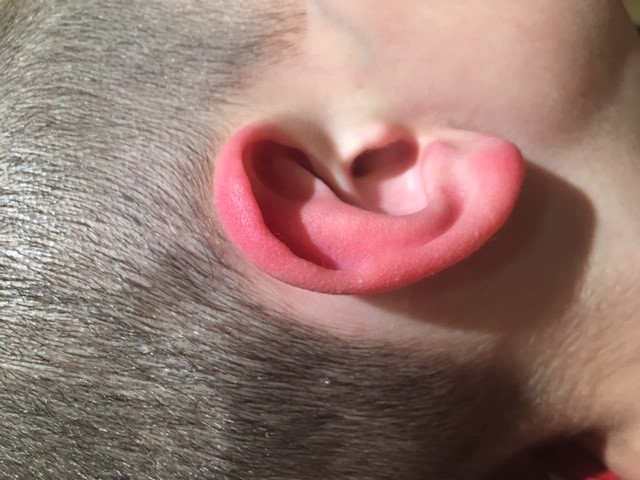Síndrome oreja roja...
WHY YOU SHOULD HEAR ABOUT THE RED EAR SYNDROME

By Warren R. Heymann, MD
July 22, 2020
Vol. 2, No. 29
 Is it my imagination that the "by the way" comments at the presumed end of a patient encounter cause the most angst? Usually, it's something like "Oh, I forgot to mention that I'm losing my hair!" Recently, at the conclusion of an extended visit, a middle-aged woman stated that periodically, her left ear would become fiery red for several hours, accompanied by a burning sensation. There was no evidence of disease that day — my quick differential of a contact dermatitis, Pseudomonas cellulitis, relapsing polychondritis, or chilblains, were not pertinent. All I could do was punt — "Why don't you see me when you get one of these episodes? I'll take a look, and assess it at that time" (while thinking that I have no idea what she has)?
Is it my imagination that the "by the way" comments at the presumed end of a patient encounter cause the most angst? Usually, it's something like "Oh, I forgot to mention that I'm losing my hair!" Recently, at the conclusion of an extended visit, a middle-aged woman stated that periodically, her left ear would become fiery red for several hours, accompanied by a burning sensation. There was no evidence of disease that day — my quick differential of a contact dermatitis, Pseudomonas cellulitis, relapsing polychondritis, or chilblains, were not pertinent. All I could do was punt — "Why don't you see me when you get one of these episodes? I'll take a look, and assess it at that time" (while thinking that I have no idea what she has)?Perhaps my patient is experiencing the red ear syndrome (RES); I was not familiar with this entity until I read the article by Cinats and Haber. (1) Wollina contends that RES is one of a triad of orphan disorders that dermatologists should recognize, along with the red scrotum and red scalp syndromes. (2)
RES was first described by Lance in 1996, detailing the features of a dozen case reports. The following is the first paragraph of his discussion: "What are the characteristics of the red ear syndrome? It is commonly unilateral and implies discomfort or burning pain as well as a change in color. The color change may involve the adjacent part of the cheek. The pain may radiate to the forehead (V-1), occiput (C-2), or a strip behind or below the mandible (C-3). It is often brought on by exercise, exposure to heat, touch, chewing, or neck movement." Prior to publication of this article, Dr. Lance stated that he presented three of these patients to the Australian Association of Neurologists a paper entitled "The Mystery of One Red Ear." (3)
 Photo courtesy of Richard Haber, MD
Photo courtesy of Richard Haber, MDNearly a quarter century later, RES remains mysterious. Most of the information about RES has been in the neurology and otolaryngology literature, so it is not surprising that dermatologists may not be familiar with the entity. There is considerable debate about the classification, pathophysiology, and treatment of this (possibly not so) rare disorder.
According to Lambru et al, RES episodes are characterized by mostly unilateral, or occasionally bilateral, attacks of paroxysmal burning sensations and reddening of the external ear. This includes the earlobe [distinguishing RES from relapsing polychondritis]. The duration of these episodes ranges from a few seconds to several hours. Attacks occur with a frequency ranging from several a day to a few per year; they may occur spontaneously or be triggered by rubbing or touching the ear, heat or cold, chewing, brushing of the hair, neck movements, or exertion. Early-onset idiopathic (primary) RES seems to be associated with migraine, whereas late-onset secondary forms of RES occur with trigeminal autonomic cephalalgias (TACs), upper cervical spine disorders, or temporo-mandibular joint dysfunction. (Please see below for their proposed diagnostic criteria primary RES.) RES is mostly refractory to medical treatments, although some migraine preventative treatments have shown moderate benefit mainly in patients with migraine-related attacks. (4) Some recent therapeutic suggestions include use of botulinum toxin (5), indomethacin (6), or propranolol. (7) A partial list of other treatments includes topical anesthetics, oral tricyclic antidepressants, and gabapentin. (1) Physical cooling of the skin may be worthwhile. (2)
The pathophysiology of RES remains to be determined. Chan et al state: "The vasomotor control of the skin of the ear is dependent on sympathetic vasoconstrictor tone as opposed to the forehead and cheek skin, which is predominantly influenced by the facial parasympathetic system as seen in trigeminal autonomic cephalalgias (TACs). It seems unlikely, therefore, that the trigemino‐parasympathetic reflex accounts for the erythema of the ear, although it is possible that an imbalance between the parasympathetic and sympathetic system may in turn result in inhibition of sympathetic tone in the ear, giving rise to vasodilation and the red ear phenomenon." It is also conceivable that irritation of cervical nerve roots or the mandibular trigeminal nerve could activate these autonomic circuits. (6) Cinats and Haber presented the case of an 11-year-old boy with daily episodes of RES accompanied by erythema and swelling of his hands and feet. Based on these findings, they suggest that RES may represent auricular erythromelalgia. The authors propose a new classification of RES including primary forms (divided into headache or erythromelalgia types) and secondary RES.
One of the joys of reading widely is experiencing an "aha" moment of recognizing the relevancy of an unknown disorder (to me) to an existing patient's problem. When my patient returns, I will strongly consider the diagnosis of the red ear syndrome (RES), thanks to the publication by Cinats and Haber.
Point to Remember: The red ear syndrome may be a primary or secondary disorder that displays symptoms similar to erythromelalgia. After ruling out other conditions that may cause auricular erythema, the diagnosis of RES should be considered — the best therapeutic approach may be multidisciplinary with assistance from neurologists and otolaryngologists.
Our expert's viewpoint
Richard M Haber MD, FRCPC
Professor of Medicine
University of Calgary
The main purpose of my article on pediatric red ear syndrome (RES) was to make this diagnosis better known to dermatologists, as most case reports of RES have appeared in the neurologic literature. I believe that some primary types of RES (such as my case in a pediatric patient) likely represent an erythromelalgia-type of RES (RES-ET). Cases such as my young boy with refractory painful erythema of his ears which could be associated with concurrent erythema of his hands and feet, strengthens the classification proposed in my article which includes RES-ET as a primary type of RES.
There is clearly a headache-associated primary type of RES (RES-HT) in which the episodes of auricular erythema affecting the whole ear including the lobule occur temporally. Interestingly, the headache and the red ear(s) may respond to treatment of the headache. The subset that is most confusing is patients with RES but with a history of headaches that are not concurrent with the auricular erythema. Whether this is a true subset of RES remains to be determined.
Although RES appears to be a rare diagnosis presenting to dermatologists, it is likely that more cases will present as a primary dermatologic complaint. When a Google search of "red ears" and "pain" is performed, the first diagnosis suggested is RES followed by relapsing polychondritis. It is therefore very likely that patients will present to a dermatologist asking about RES.
Treatment of RES, especially the RES-ET can be extremely challenging and I agree with Dr. Heymann's suggestion that difficult cases may best be managed with a multidisciplinary approach with assistance from neurologists and otolaryngologists but could also require a referral for assessment in specialized complex pain clinics similar to refractory cases of hand and foot erythromelalgia.
When it comes to ear syndromes, I suggest that dermatologists be well "red" and consider the diagnosis of RES.
Proposed diagnostic criteria for primary red ear syndrome (reference 4)
A. At least 20 attacks fulfilling criteria B-E
B. Episodes of external ear pain lasting up to 4 hours.
C. The ear pain has at least two of the following characteristics:
-Burning quality
-Unilateral location
-Mild to moderate severity
-Triggered by cutaneous or thermal stimulation of the ear.
D. The ear pain is accompanied by ipsilateral redness of the external ear.
E. Attacks occur with a frequency of ≥1 per day, although cases with lower frequency may occur.
F. Not attributed to another disorder.
Cinats AK, Haber RM. Pediatric red ear syndrome: A case report of an erythromelalgia type and review of the literature. Pediatr Dermatol 36: 686-689.
Wollina U. Three orphans one should know: Red scalp, red ear, and red scrotum syndrome. J Eur Acad Dermatol Venereol 2016; 30: e169-170.
Lance JW. The red ear syndrome. Neurology 1996; 47: 617-620.
Lambru G, Miller S, Matharu MS. The red ear syndrome. J Headache Pain 2013; 14: 83.
Castellanos-Gonzalez M, Manueles F. Martos MG, Rodriguez MA. Successful treatment of red ear syndrome with botulinum toxin type A. Indian J Dermatol Venereol Leprol 2019; 85: 107-108.
Chan TLH, Becker WJ, Jog M. Indomethacin-responsive idiopathic red ear syndrome: Case report and pathophysiology. Headache 2018; 58: 306-308.
Hernández CR, Loza SM, López RL, del Mar García Romero. Red ear syndrome in a pediatric patient. Pediatr Emerg Care 2018; 34: e199-e200.
All content found on Dermatology World Insights and Inquiries, including: text, images, video, audio, or other formats, were created for informational purposes only. The content represents the opinions of the authors and should not be interpreted as the official AAD position on any topic addressed. It is not intended to be a substitute for professional medical advice, diagnosis, or treatment.
posted by dermatica at
July 29, 2020
![]()
![]()

0 Comments:
Post a Comment
Subscribe to Post Comments [Atom]
<< Home